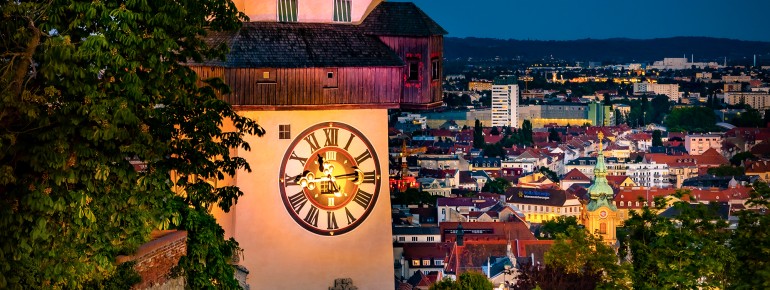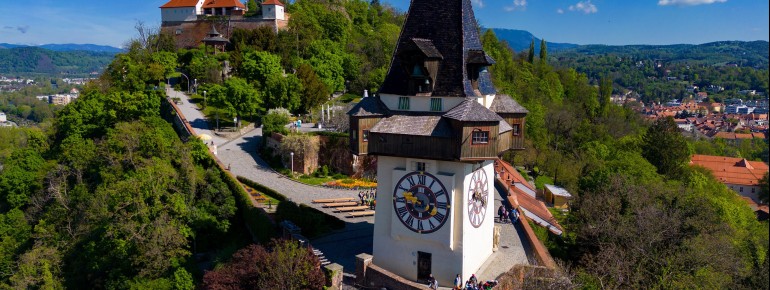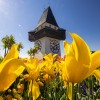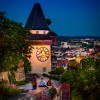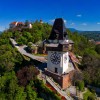Contents
Description
The Graz Clock Tower, also known as the "Schloßberg Tower," is the landmark of Graz. The tower stands 28 meters tall, is one of the city's oldest buildings, and is part of the Schlossberg, one of the most well-known hills in Graz. From the tower's platform, visitors are treated to a breathtaking view over the rooftops of Graz and the hills and valleys in the surrounding area.
Probably the most famous detail of the tower are its large clocks, which are mounted on the facades and are visible from afar. They are a masterpiece of the clockmaker's art and have been restored several times over the years. The four large dials each have a diameter of more than five meters and the hands are gilded. The special feature of the hands on the Graz clock tower is their unusual arrangement: the large hand indicates the hours, while the small hand indicates the minutes. This unconventional arrangement has historical reasons, as earlier tower clocks often had only one large hand for the hours. When a minute hand was later added, limited space on the tower dictated that it be made smaller.
Ascent options
The ascent to the tower can be made either by a leisurely walk up the Schlossberg or by the modern funicular railroad in one and a half minutes.An even more speedy way to reach the clock tower on the Schlossberg is to take the Schlossberg lift. By the way, there is an option to slide all the way down via a tube system.The tube runs in several loops around the elevator shaft and takes about 40 seconds.
Events
Furthermore, many festivals and events take place near the tower. These include the annual Uhrturmlauf (Clock Tower Run), where participants conquer the tower's stairs, the "Long Night of Museums," which offers insights into the tower's history, and occasional musical performances.
Historical Information

The history of this tower dates back to the 13th century, when it was built as a defensive tower to defend the city.Over time, the tower has been rebuilt and expanded several times to meet changing needs.
Inside the tower, three bells are still preserved today, each of which tells its own story: The hour bell, dated 1382, is considered the oldest bell in Graz and chimes on the hour. The fire bell, dating from 1645, in turn, warns of fire danger in the various districts of Graz. On the other hand, the Armesünderglocke, which was cast around 1450, once rang during executions and marked the curfew in the 19th century.
How to get there

Car: For those arriving by car, parking is available near the Schlossberg. After parking, visitors can continue the ascent on foot, by Schlossberg lift or by funicular.
Public Transportation: Graz's public transportation network also offers ways to reach the Schlossberg.Buses and streetcars connect various parts of the city with the center, from where you can continue to the clock tower on foot, by Schlossberg lift or funicular.




